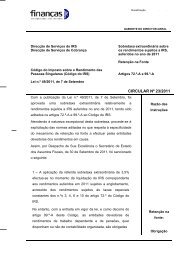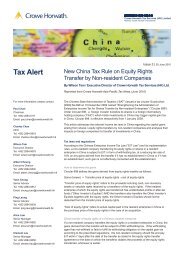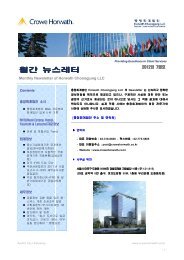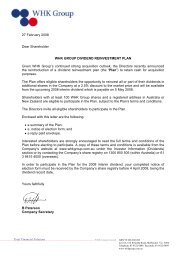Guidance Paper - The Institute of Risk Management
Guidance Paper - The Institute of Risk Management
Guidance Paper - The Institute of Risk Management
You also want an ePaper? Increase the reach of your titles
YUMPU automatically turns print PDFs into web optimized ePapers that Google loves.
III Constructing a risk appetite<br />
“Managing the right levers”<br />
301<br />
302<br />
Level<br />
Strategic<br />
Tactical<br />
Project/<br />
Operational<br />
In Section II <strong>of</strong> this paper we explored the main issues in designing the risk<br />
appetite framework: in this section, we look at each <strong>of</strong> the main elements in<br />
the middle <strong>of</strong> the framework in more detail.<br />
At the heart <strong>of</strong> the risk appetite framework, once an organisation<br />
understands their capability to manage risk, we have the main issues that an<br />
organisation has to deal with in setting and monitoring its risk appetite.<br />
<strong>The</strong>se are set out in the diagram below:<br />
Figure 8 - <strong>Risk</strong> appetite - Main Issues<br />
Propensity<br />
to take risk<br />
Delegation<br />
<strong>Risk</strong> Taking<br />
Propensity<br />
to exercise<br />
control<br />
Exercising<br />
Control<br />
Escalation<br />
Measurement<br />
Stakeholder<br />
Value<br />
<strong>Risk</strong><br />
Metrics<br />
Control<br />
Metrics<br />
Levels <strong>of</strong> risk<br />
appetite<br />
Strategic<br />
303<br />
This framework envisages at<br />
least three levels <strong>of</strong> risk<br />
appetite as set out in the<br />
following paragraphs.<br />
304<br />
At a strategic level, risk<br />
appetite is predominantly<br />
about the risks or types <strong>of</strong> risks<br />
that an organisation has a comparative<br />
advantage in managing (or indeed<br />
knowing that they can neither manage<br />
nor mitigate). <strong>The</strong>se provide it with its<br />
competitive advantage (private sector) or<br />
its ability to achieve its objectives (public<br />
or third sector). <strong>Risk</strong> appetite at the<br />
strategic level will also be about deciding<br />
from which risks or types <strong>of</strong> risk the<br />
organisation needs to protect itself.<br />
Strategic <strong>Risk</strong><br />
Some examples <strong>of</strong> strategic risks:<br />
• <strong>Risk</strong>s in connection with decisions<br />
about outsourcing or maintaining<br />
processes and competencies in-house.<br />
• <strong>Risk</strong>s concerning new product<br />
developments, such as new<br />
innovations, R&D, new product<br />
lines.<br />
• <strong>Risk</strong>s concerning new sources<br />
<strong>of</strong> finance, such as the optimal<br />
debt:equity ratio, banking<br />
covenants, headroom and liquidity.<br />
• <strong>Risk</strong>s concerning acquisitions or<br />
disposals including the likelihood <strong>of</strong><br />
achieving organisational objectives<br />
or destroying shareholder value.<br />
23

















